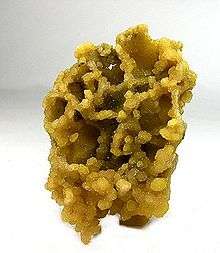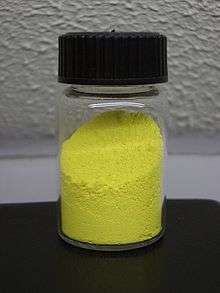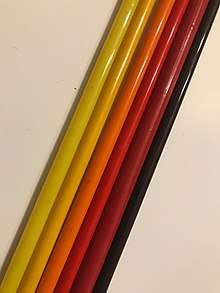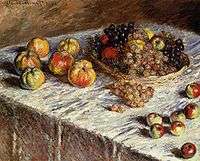Cadmium pigments
Cadmium pigments are a class of pigments that contain cadmium. Most of the cadmium produced worldwide has been for use in rechargeable nickel-cadmium batteries, which have been replaced by other rechargeable nickel-chemistry cell varieties such as NiMH cells[2], but about half of the remaining consumption of cadmium, which is approximately 2,000 tonnes (2,200 short tons) annually, is used to produce colored cadmium pigments. The principal pigments are a family of yellow, orange and red cadmium sulfides and sulfoselenides, as well as compounds with other metals.[3]
| Cadmium orange | |
|---|---|
Orange cadmium pigment | |
| Hex triplet | #ED872D |
| sRGBB (r, g, b) | (237, 135, 45) |
| CMYKH (c, m, y, k) | (0, 43, 81, 7) |
| HSV (h, s, v) | (28°, 81%, 93%) |
| Source | [1] Charts |
| ISCC–NBS descriptor | Strong orange |
| B: Normalized to [0–255] (byte) H: Normalized to [0–100] (hundred) | |
| Cadmium red | |
|---|---|
Red cadmium pigment | |
| Hex triplet | #E30022 |
| sRGBB (r, g, b) | (227, 0, 34) |
| HSV (h, s, v) | (351°, 100%, 89%) |
| Source | [Unsourced] |
| ISCC–NBS descriptor | Vivid reddish orange |
| B: Normalized to [0–255] (byte) | |
| Cadmium green | |
|---|---|
| Hex triplet | #006B3C |
| sRGBB (r, g, b) | (0, 107, 60) |
| HSV (h, s, v) | (154°, 100%, 42%) |
| Source | [1] |
| ISCC–NBS descriptor | Deep yellowish green |
| B: Normalized to [0–255] (byte) | |
| Cadmium yellow | |
|---|---|
Yellow cadmium pigment | |
| Hex triplet | #FFF600 |
| sRGBB (r, g, b) | (255, 246, 0) |
| CMYKH (c, m, y, k) | (0, 4, 100, 0) |
| HSV (h, s, v) | (58°, 100%, 100%) |
| Source | [Unsourced] |
| ISCC–NBS descriptor | Vivid greenish yellow |
| B: Normalized to [0–255] (byte) H: Normalized to [0–100] (hundred) | |
Artists' paints


Brilliantly colored, with good permanence and tinting power, cadmium yellow, cadmium orange and cadmium red are familiar artists’ colors, and are frequently employed as architectural paints, as they can add life and vibrancy to renderings. Their greatest use is in the coloring of plastics and specialty paints, which must resist processing or service temperatures up to 3,000 °C (5,430 °F).[4] The colorfastness or permanence of cadmium requires protection from the element's tendency to slowly form carbonate salts with exposure to air. Most paint vehicles accomplish this, but cadmium colors will fade in fresco or mural painting.
The following are commonly used as pigments in artists' paints:
- Cadmium yellow is cadmium sulfide (CdS), C.I. Pigment Yellow 37.
- Cadmium sulfoselenide is a solid solution of CdS and cadmium selenide; depending on the sulfur-to-selenium ratio, C.I. Pigment Orange 20 or C.I. Pigment Red 108 is obtained.
- Zinc cadmium sulfide is a greenish, solid solution of CdS and zinc sulfide, C.I. Pigment Yellow 35.
- Cadmium yellow is sometimes mixed with viridian to give a bright, pale green mixture called cadmium green.
When first introduced, there were hardly any stable pigments in the yellow-to-red range, with orange and bright red being very troublesome. The cadmium pigments eventually replaced compounds such as mercury(II) sulfide (the original vermilion) with greatly improved lightfastness.
Cadmium pigments are known for excellent lightfastness, although the lighter shades can fade in sunlight.[5] A cadmium yellow paint was frequently used on Bob Ross' TV show The Joy of Painting.
Coloring art glass

Cadmium compounds are utilized in coloring borosilicate glass[6] used by artists in lampworking. The palette is often referred to as "cadmium colors" or "cadmium-based colors" and is marked by uniquely bright and saturated tones not found in other colored glass. Cadmium pigments used in borosilicate have a relatively short history, with the first commercial formulations hitting the market in 2000 under the name Crayon Colors by Henry Grimmett of Glass Alchemy.[7]
Cadmium-compound-containing glass exhibits a characteristically low heat tolerance when melted, and therefore must be treated with caution when lampworking to avoid boiling off of the cadmium sulfide. CdS has a boiling point of 980 °C (1,800 °F), putting its maximum temperature tolerance as a pigment not far above the working temperature range for borosilicate, which has a softening point of approximately 850 °C (1,560 °F).[8][9]
Safety
Cadmium sulfide is not very toxic (LD50 above 5,000 mg/kg) when used as a pigment, although acute exposure to cadmium vapors from welding is harmful.[3]
The cadmium pigments have been partially replaced by azo pigments. These have significantly inferior lightfastness,[10] but still good,[11] and they have the advantage of both being cheaper and non-toxic. In some countries, consumer activists such as Michael Vernon in Australia were successful in banning the use of cadmium pigments in plastics that could be used for toy manufacture, owing to the toxicity of cadmium.
In December 2013, the Swedish Chemicals Agency (KEMI) proposed a case to the European Chemicals Agency (ECHA) in favor of restricting or banning cadmium use in artists’ paints, as cadmium in pigments used in other types of paints was already restricted and regulated via TARIC codes and REACH Annex XVII. This proposal stated that cadmium in the body leads to increased risk of bone fractures and breast cancer as well as an array of environmental impacts, and that paint washed down the drain is absorbed by crops that are then consumed, increasing the average dietary cadmium intake. This can cause an array of health effects, including kidney and liver damage, skeletal damage, several types of cancers and death.[12] [13] [14] KEMI's proposal was ultimately declined.
In a June 2015 article of Just Paint, published by Golden Artist Colors, the company argued against KEMI's proposal, offering that "There are no alternatives that match all of the characteristics of cadmium pigments." This statement was also included in Golden's response to KEMI's request for information on cadmium-pigmented artists’ paints while the agency was composing its ban proposal. The article also stated that a ban would be technically feasible for some artists, but not all, and that "cadmium colors are not for use by children, should not be spray applied or sanded, and unless one is properly protected from exposure and in a non-household setting, use of dry cadmium pigment should be avoided." [15] [16]
Inhalation poses the greatest risk from cadmium pigments, though the chemical is very low-risk when sealed within a pigment particle because of its insolubility. The use of chalk pastels containing cadmium colors is among the highest risks for artists, as these pastels create a dust that can be inhaled.[17]
Cadmium is introduced into the body most commonly through smoking, and in individuals who do not smoke, the next most common instance is through dietary consumption.[18]
Examples of cadmium pigments in art
.jpg) Winslow Homer, "Hunter in the Adirondacks" (1892)
Winslow Homer, "Hunter in the Adirondacks" (1892) Vincent van Gogh, "Grapes, Lemons, Pears, and Apples" (1887)
Vincent van Gogh, "Grapes, Lemons, Pears, and Apples" (1887)%2C_1890-91%2C_65.3_x_100.4_cm%2C_25_11-16_x_39_1-2_in.%2C_The_Art_Institute_of_Chicago.jpg) Claude Monet, "Wheatstacks (Sunset, Snow Effect)" (1890–91)
Claude Monet, "Wheatstacks (Sunset, Snow Effect)" (1890–91) Claude Monet, "Still Life with Apples and Grapes" (1880)
Claude Monet, "Still Life with Apples and Grapes" (1880)
See also
References
- "THE MOTHER OF ALL HTML COLOR CHARTS index and reference | Color World | Color, Chart, Color names". tx4.us. Archived from the original on 22 November 2012. Retrieved 11 May 2019.
- "MEPs Ban Cadmium from Power Tool Batteries and Mercury from Button Cells". European Parliament.
- Müller, Hugo; Müller, Wolfgang; Wehner, Manfred; Liewald, Heike. "Artists' Colors". Ullmann's Encyclopedia of Industrial Chemistry. Weinheim: Wiley-VCH. doi:10.1002/14356007.a03_143.pub2.
- "Cadmium Pigments". Archived from the original on 12 February 2011. Retrieved 30 November 2010.
- Douma, Michael (2008), "History of Cadmium Yellow", Pigments Through the Ages, retrieved 31 July 2013
- "Borosilicate glass material properties". Adams & Chittenden Scientific Glass. Retrieved 12 April 2019.
- "About Us". Glass Alchemy. Retrieved 5 November 2018.
- Weissler, G. L.; Carlson, R. W., eds. (1980). Vacuum Physics and Technology (1st ed.). New York: Academic Press. ISBN 9780124759145. OCLC 5170642.
- "Cadmium sulfide". PubChem. NCBI. Retrieved 5 November 2018.
- Johansen, Tony (6 May 2006). "Yellow". Making Artist's Paint. Archived from the original on 5 February 2012. Retrieved 31 July 2013.
- Jill (6 January 2010). "Yellow". Art School at Home. Retrieved 31 July 2013.
- Kawasaki, Takashi; Kono, Koichi; Dote, Tomotaro; Usuda, Kan; Shimizu, Hiroyasu; Dote, Emi (2004). "Markers of cadmium exposure in workers in a cadmium pigment factory after changes in the exposure conditions". Toxicology and Industrial Health. 20 (1–5): 51–56. doi:10.1191/0748233704th189oa. PMID 15807408.
- Kim, Hyun-Soo; Kim, Yeo-Jin; Seo, Young-Rok (December 2015). "An Overview of Carcinogenic Heavy Metal: Molecular Toxicity Mechanism and Prevention". Journal of Cancer Prevention. 20 (4): 232–240. doi:10.15430/JCP.2015.20.4.232. ISSN 2288-3649. PMC 4699750. PMID 26734585.
- Järup, Lars (1 December 2003). "Hazards of heavy metal contamination". British Medical Bulletin. 68 (1): 167–182. doi:10.1093/bmb/ldg032. ISSN 0007-1420. PMID 14757716.
- Gavett, Ben. "Will Cadmium Colors Always be on the Palette? (Part 2)". Just Paint. Golden Artist Colors, Inc. Retrieved 5 December 2018.
- "Annex XV restriction: Report proposal for a restriction" (PDF). ECHA. Retrieved 5 December 2018.
- Hoakley (15 June 2018). "Pigment: Controversial Cadmiums, yellow to red". The Eclectic Light Company. Retrieved 5 December 2018.
- "Cadmium (EHC 134, 1992)". InChem. IPCS. Retrieved 5 December 2018.
Further reading
- Fiedler, I.; Bayard, M. A. (1986). "Cadmium Yellows, Oranges and Reds". In Feller, R. L. (ed.). Artists' Pigments: A handbook of their history and characteristics. 1. Oxford University Press. p. 65–108. ISBN 9780894680861.
External links
- "Cadmium and compounds". National Pollutant Inventory. Archived from the original on 10 December 2006.
- "Cadmium yellow". Pigments through the Ages. WebExhibits.
- "Cadmium orange". Pigments through the Ages. WebExhibits.
- "Why are cinnabar, vermilion, and cadmium orange colored?". Causes of Color. WebExhibits.
- Cadmium yellow, ColourLex
- Cadmium orange, ColourLex
- Cadmium red, ColourLex